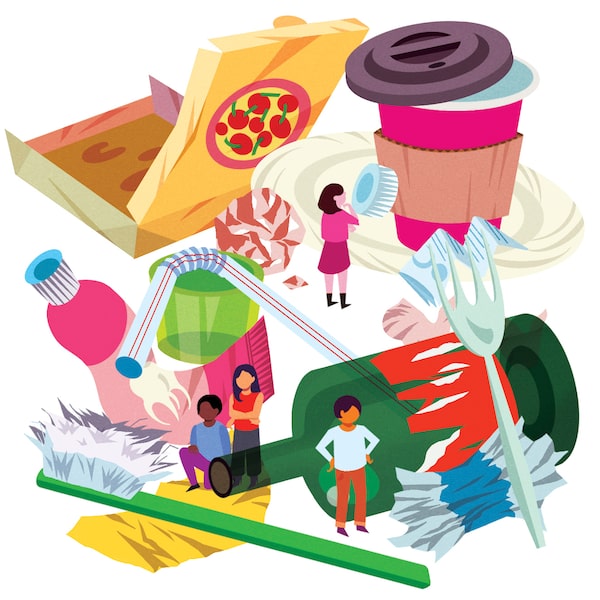Subscribe to the Globe Climate newsletter to stay up to date on environment and climate change news
Kate Pepler, owner and operator of The Tare Shop, pumps shampoo into a jar in the zero-waste shop in Halifax on Dec. 19, 2019.Darren Calabrese/The Globe and Mail
When Kate Pepler in Halifax first decided to join the zero-waste movement in 2016, she went all in. She vowed to never buy another cup of coffee unless she had a reusable mug. She found a network of stores that would let her use her own containers to buy food in bulk. She made her own toothpaste with baking soda and coconut oil, and deodorant with arrowroot powder, and bought her shampoo in bars instead of bottles. She picked up her dog’s poop with littered Tim Horton’s cups, to avoid using the plastic bags. She washed her windows with newspaper. She gave up potato chips because she couldn’t recycle the bags.
Ms. Pepler is a member of growing Canada’s zero-waste community, whose goal is to go beyond sorting recyclables, to dramatically reduce garbage by buying less and repurposing more. Zero-waste advocates have a lively and varied social-media presence, where they discuss how to reduce overpackaging and slow climate change, swap recipes for DIY dry shampoo and argue about how best to dispose of the plastic spoons purchased by a misguided relative.
Kate Pepler poses with a jar of waste from her home, in her zero-waste shop in Halifax.Darren Calabrese/The Globe and Mail
The principles of the movement, in descending order of importance, are: refuse (to buy in the first place), reuse (what you already own), reduce (plastic packaging), rot (compost) and recycle. Most of the strategies focus on cooking, cleaning and shopping, which likely explains why women dominate the chat groups. Advocates of the zero-waste movement also started the informal “mason-jar challenge," where participants try to produce only as much garbage in one year that will fit into a single jar.
If this all sounds a bit daunting, ease your eco-anxiety: You can start small, Ms. Pepler says, and still make a difference. A favourite line quoted among advocates of zero waste is that the environment needs a lot of people doing a little, not a few people doing it perfectly. Anyway, Ms. Pepler says, nobody is perfect. Even the mason-jar challenge is aspirational for most people, she says. Having a dog, for instance, is an automatic fail: Dog-food bags don’t fit, and can’t be recycled.
The Tare Shop, a zero-waste bulk store, coffee shop, and community hub in Halifax.Darren Calabrese/The Globe and Mail
Ms. Pepler opened the Tare Shop, the first zero-waste café and bulk store in Halifax in October, 2018. Her own mason jar, full mostly of fruit stickers and clothes tags, is now a prop that she brings to public talks. She tells her customers to keep making intentional choices, until they become habit. One day it won’t even occur to you to buy that latte in a single-use cup.
With that endgame in mind, we asked five zero-waste experts for advice on how the average chip-loving, Sephora-shopping Canadian can get started.
1. Begin at the scene of the crime: your garbage bag
Kyleen McKinley, a married mother of a five-year-old boy, runs a home daycare in Halifax, and when the city reduced the number of garbage bags residents were allowed, her family had to go begging for extra trash room from a neighbour. So Ms. McKinley began picking through her garbage bags. “There were a lot of single-serve yogurt cups,” she remembers. One item at a time, she made a change – buying food in bulk, using hand towels instead of paper towels, ordering pizza in a box instead of takeout Chinese food in plastic containers.
They built up their backyard vegetable garden to cut down grocery-store purchases such as plastic-wrapped cucumbers. They downsized their grocery list, and stopped buying five kinds of snack crackers, for example, when one will do. Slowly, the garbage sitting on the curb every two weeks began to shrink. “It’s a rush,” she says. “You can actually see your results."
2. Take one room at a time
When Sophi Robertson in Toronto decided that she wanted to aim for a zero-waste household after hearing how millions of coffee cups ended up in the city’s landfills each day, she jumped in – and crashed. She tried to make all her food from scratch and dictate new rules for her family: “That was not fun for them, or me.” She started over – trading paper towels for washable rags, cutting down on plastic that came into the house, avoiding items that could only be used once.
Zero-waste advocates often recommend focusing on the kitchen or bathroom first. Don’t throw out everything to create a clean slate; that just makes more garbage. “Look in your cabinet and see what is running out,” Ms. Robertson says. Plastic toothbrushes can be swapped for compostable bamboo ones (the Q-tips, too); the plastic bottle of body wash for a bar of soap. Buy toilet paper that comes wrapped in paper, not plastic. Ms. Robertson estimates that she makes her own deodorant – without the plastic packaging – for $5 a year. DIY is key to achieving zero waste – for cosmetics, and cleaning supplies. Or shop for ones that come in refillable containers.

Illustration by Jenn LivThe Globe and Mail
3. Don’t get sucked into the zero-waste consumer economy
You do not really need a zero waste “starter kit,” whatever sites such as Goop are pitching – not even an avocado-peel straw. (Zero-waste tip: Don’t use a straw.) An eco-industry of reusable towels and bamboo hairbrushes has sprung up, catering to zero-waste “consumers,” even though the whole idea is to shop less, or buy secondhand. “Sometimes it’s a stepping stone" to getting started, Ms. Robertson says. She’s not criticizing anyone who buys a stainless-steel straw, the “mascot” of zero waste. “I bought one," she acknowledges. And then never used it.
4. Hack like MacGyver
When the cobbler said Ms. Robertson’s cracked rubber boots weren’t worth fixing, she decided otherwise. She cut hearts from her dog’s old winter booties, glued the plastic over the cracks in her boots, and got another season out of them. When the rubber grips on the family’s car-phone holder wore out, she reattached it to the dash with elastic bands, rather than buy a new one. “I really sparks my creativity, which I didn’t think I had,” Ms. Robertson says. When her daughter begged for a new pink book bag, she found discount unicorn decals to give the old one an upgrade. Some of her life hacks come from the online community; others she brainstorms on her own. But many of the repair and reuse strategies, she says, are a return to the way previous generations were careful with their possessions. In her house, that means using a few new items as possible. Ms. Robertson has even purchased eyeglass frames secondhand on Kijiji.
5. Don’t obsess about glitter (or the bag of plastic forks you found in your drawer)
Keoryn Davis, a mother of four young children in Quesnel, B.C., whose family of six produces one bag of garbage a week, doesn’t use glitter anymore because it’s a microplastic. But one errant bottle of the stuff, Ms. David says, can spark a fierce debate. Should you burn it to ash, so it doesn’t get into the water table? Glue it into a clump, so it’s inert in the landfill? Drive to your local school and donate it? “Everyone has such strong opinions about what you should do with this tiny little bit of plastic that you found in your house,” Ms. Davis says. “It’s extreme.” Concentrate on the big pictures, she says, such as trading in your plastic creamers for a recyclable container. That’s 52 weeks of plastic not going into the landfill, she says. “Who cares if you threw that one bottle of glitter away?”
6. Don’t practice “wishful” recycling
This is the practice of tossing an item in a blue bin and hoping the recycling fairies will work their magic. This can contaminate the recycling and compost stream and force items into landfill, says Barb Hetherington, the director of Zero Waste Canada. “Everybody should know their local recycling rules.”

Illustration by Jenn LivThe Globe and Mail
7. Sometimes it’s okay to buy bread in a plastic bag
As the zero-waste Facebook feeds readily demonstrate, choices often have pros and cons, and not everyone reaches the same conclusion. Ms. Davis, for instance, uses micofibre cloth so she doesn’t need cleaning supplies – some of her friends worry more about the microplastic getting in the water supply. In the beginning, Ms. Robertson says, she thought eliminating plastic packaging was the goal, no matter what. Now, she focuses on making better use of items already in circulation, and doesn’t feel guilty buying discounted bread at the grocery store. “Am I going to waste my time thinking about this item wrapped in plastic,” she says, “or am I going to celebrate the fact that I rescued this bread from the landfill?”
8. Don’t be discouraged by the waste you can’t reduce
Some things will simply be too expensive, too labour intensive or just impossible right now. Ms. Davis doesn’t have curbside composting in her small city, so she has to put meat scraps in a garbage bag. Ms. McKinley would love to get bottled milk like her grandmother’s generation, but for now she can only get the kind her family drinks in plastic at the grocery store. Reducing waste is getting easier every year, she says, as more stores respond, and shopping less creates room to spend more on local items. But sometimes, you have to do what is practical for your household – even if that means ordering from Amazon once in a while. (She uses the boxes for craft projects.) “I can only do the best I can," she says. “If I only have $20 to fill my kid’s stocking, then I am going to the dollar store." Celebrate the zero-waste wins, she advises, and don’t stress about the losses.
9. Don’t judge the inside of other people’s houses by what’s on the curb of yours
As Ms. Heatherington points out, you may create one small bag of garbage, but your neighbour may be saving the environment by using a 20-year-old couch or Grandma’s antiques. It’s easy to get high-minded, zero-waste advocates says, and there is often more than a whiff of judgment on the Facebook feeds. But many sustainable choices that people make – such as not flying to another continent for vacation – aren’t always obvious. The best approach is to a be role model, Ms. Pepler says: Let your travel mug speak for itself when your friend double-cups their Tim Horton’s coffee.
9 more tips to go zero-waste:
- Use a plate to cover bowls of leftovers in the fridge instead of Saran Wrap
- Save your veggie scraps (onion skins, garlic skins, pepper tops, carrot tops) and make your own veggie stock (save money and avoid the packaging)
- Don’t buy a zero-waste lunch kit. Create your own: Use an old takeout container, a dishcloth and a fork and knife from home
- Make rags out of old sheet, T-shirts and towels and use them in place of paper towels. You can also wash your windows with newspapers
- Save fruit stickers on aluminum foil and use them instead of tape
- Bring your own bib to the dentist
- Use other litter to pick up your dog’s poop, when putting it in a public garbage can
- Bring a pillow case to buy bread at the baker
- Ask the deli counter if you can take your sandwich home in your own container